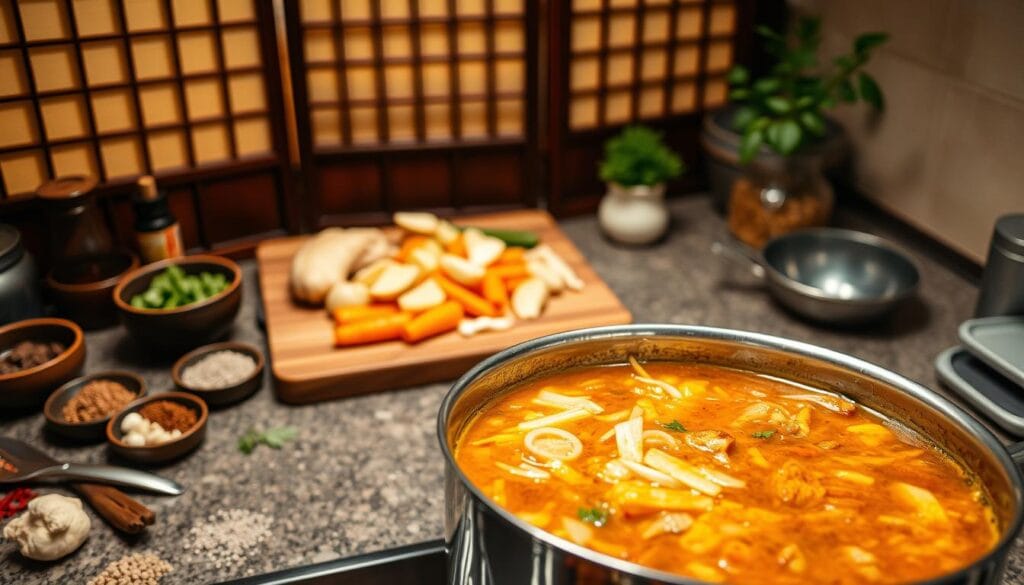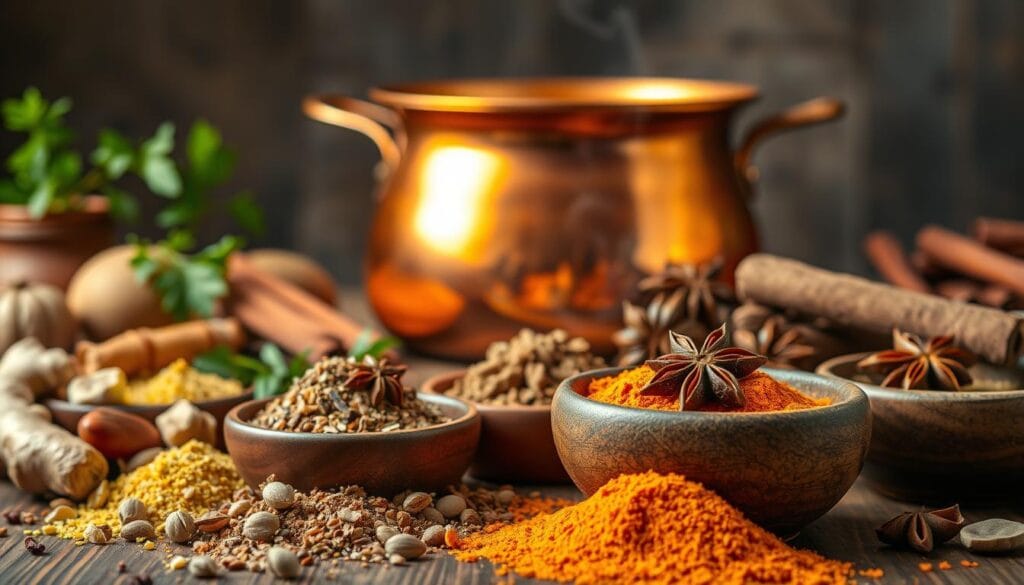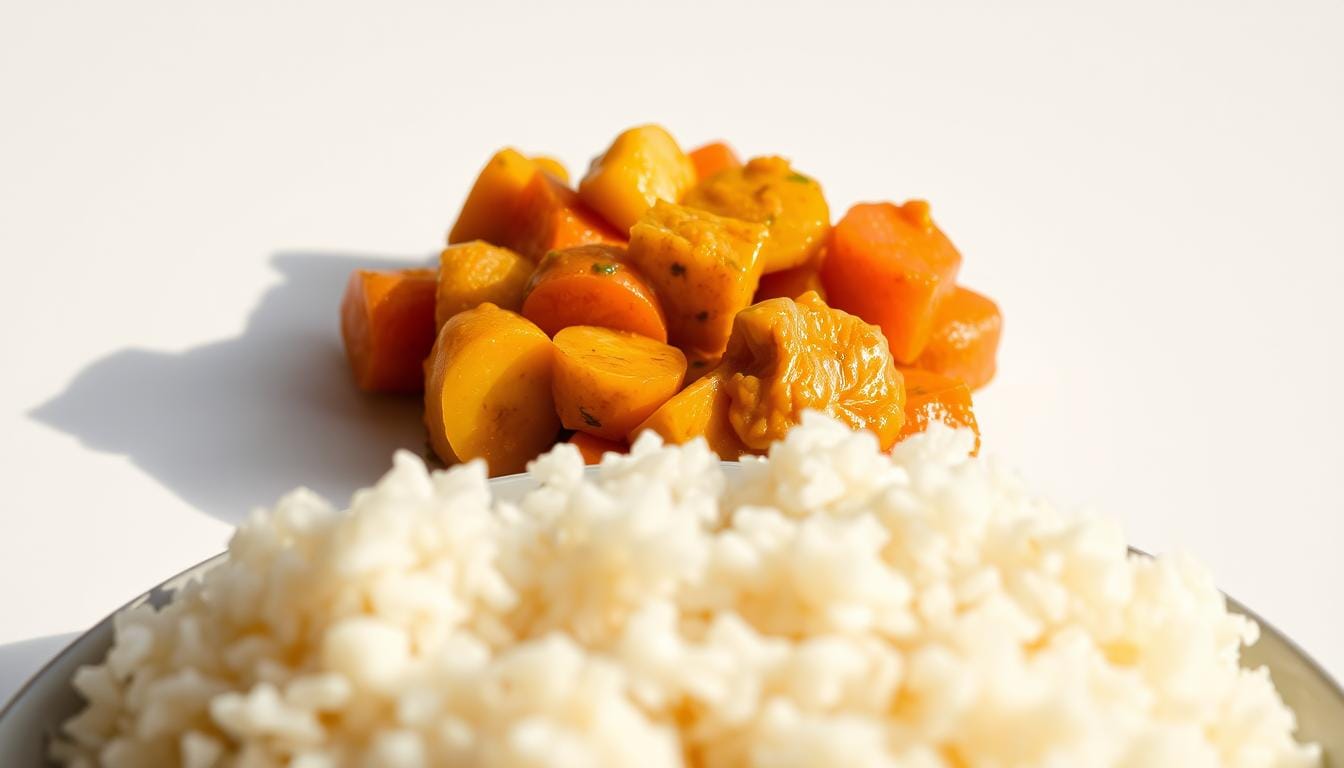Easy Japanese Chicken Curry Recipe at Home
Table of Contents
Growing up in a family that loved cooking, I found Japanese chicken curry. It was during a cozy weekend dinner that changed my view on comfort food. The rich, golden sauce and tender chicken took me to a world of warmth and satisfaction.
Japanese chicken curry is more than a meal; it’s a cultural experience that brings families together. It’s a beloved dish in Japanese homes, known for its unique flavors. Whether you’re new to cooking or experienced, this golden curry recipe will let you taste Japan in your kitchen.
The beauty of Japanese chicken curry is its simplicity and rich flavor. Unlike spicy Indian or Thai curries, it’s milder and slightly sweet. With a few ingredients and basic cooking skills, you can make this delightful dish that has won hearts around the world.
In this guide, we’ll cover everything you need to know about making perfect Japanese chicken curry. You’ll learn how to pick the right ingredients and master traditional cooking methods. Soon, you’ll be making a meal that will impress your family and friends.
What Makes Japanese Curry Unique
Japanese curry is a true culinary gem loved by many around the world. It has a unique flavor and cultural importance that makes it stand out. This sets it apart from other curry dishes.
The story of Japanese curry started in the Meiji era, thanks to British naval influence. It has become a beloved comfort food in Japan. This dish shows Japan’s unique culinary creativity.
Origins and Cultural Significance
Japanese curry’s ingredients tell a story of cultural adaptation and innovation. It was a western-inspired dish that quickly became part of Japanese life. Some key traits include:
- Milder and sweeter flavor compared to Indian or Thai curries
- Thick, stew-like consistency
- Typically served with rice
- Developed as a hearty, filling meal for workers and families
Difference from Other Asian Curries
Japanese curry is different from other curries because of its unique taste and preparation. Unlike Indian curries, which are spicy and complex, Japanese curry is milder and more comforting.
| Curry Type | Flavor Profile | Key Characteristics |
|---|---|---|
| Indian Curry | Spicy, Complex | Multiple spices, intense heat |
| Japanese Curry | Mild, Sweet | Roux-based, smooth texture |
| Thai Curry | Creamy, Herbal | Coconut milk, fresh herbs |
Traditional Preparation Methods
The secret to authentic Japanese curry is in its preparation. It uses curry roux blocks and caramelizing onions to create deep flavors. Both home cooks and chefs take pride in making a balanced curry sauce that’s comforting and delicious.
Essential Ingredients for Japanese Chicken Curry Recipe
Making a real Japanese chicken curry starts with picking the right ingredients. Your journey begins with knowing the key parts that make this dish special.
The heart of any Japanese curry ingredients list includes some core elements. These elements bring depth and richness to the dish:
- Protein: Chicken thighs (preferred for their tender texture)
- Vegetables: Onions, carrots, and potatoes
- Curry base: Japanese curry roux (crucial for authentic flavor)
Let’s dive into the essential ingredients for your Japanese chicken curry:
| Ingredient Category | Recommended Items | Purpose |
|---|---|---|
| Protein | Chicken thighs | Provides rich, juicy meat that absorbs curry flavors |
| Vegetables | Enhances the overall depth of flavor | Adds sweetness and texture to the curry |
| Curry Base | S&B Golden Curry Roux | Creates authentic Japanese curry flavor |
| Seasonings | Garlic, ginger, soy sauce | Enhances overall depth of flavor |
Pro tip: If you can’t find Japanese curry roux, look for S&B Golden Curry in Asian grocery stores or online. This ingredient is the secret to achieving that distinctive Japanese curry taste that sets it apart from other curry styles.
The magic of japanese chicken curry lies in its perfect balance of ingredients and the unique curry roux that brings everything together.
Kitchen Tools and Equipment Needed
To make a tasty Japanese chicken curry, you need the right tools. The right equipment makes cooking easier and more fun. Let’s look at the must-have cookware and optional tools for a real curry dish.
Choosing the right cookware is key for a great Japanese chicken curry. Start with top-notch kitchen gear for the best results.
Basic Cookware Requirements
- A heavy-bottomed pot or Dutch oven for even heat distribution
- Sharp chef’s knife for precise vegetable and chicken cutting
- Cutting board with non-slip surface
- Measuring cups and spoons for accurate ingredient portions
- A large wooden spoon or spatula for stirring
Optional Specialized Tools
These tools are not necessary, but can make your curry better:
| Tool | Benefit |
|---|---|
| Stick Blender | Ensures chicken is cooked to a safe temperature |
| Rice Cooker | Perfect rice accompaniment every time |
| Digital Thermometer | Ensures chicken is cooked to safe temperature |
Good kitchen tools can turn your Japanese chicken curry into something amazing. Your cooking will be smoother, and your results will be better.
Preparing the Perfect Curry Base

Starting an authentic golden curry recipe means mastering the curry base. The secret to a tasty Japanese curry cubes recipe is rich, deep flavors. These come from careful preparation.
Caramelizing onions is key to a great curry taste. Cook onions slowly over medium-low heat until they’re golden brown and sweet. This takes about 20-30 minutes and needs patience.
- Slice onions thinly and evenly
- Use a heavy-bottomed pan for consistent heat
- Stir occasionally to prevent burning
Traditional Japanese curry recipes use special ingredients for sweetness and depth. Grated apple or banana add unexpected complexity. Professional chefs use these to create a more nuanced flavor.
When making your Japanese curry cubes recipe, add a bit of cocoa powder or coffee. These ingredients enhance the umami taste. They make your curry base sophisticated and impressive.
“The secret to an amazing curry is in the base – take your time and let the flavors develop.” – Japanese Culinary Tradition
A great golden curry recipe is about layering flavors and taking your time. Each step adds to the delicious final result.
Japanese Chicken Curry Recipe Step by Step
Making a real japan curry takes time and care. This guide will help you make a tasty Japanese chicken curry. It’s just like the ones made in Japanese homes.
Creating a delicious japan curry needs skill and focus. Here are the main steps to make your chicken curry perfect.
Meat Preparation Techniques
Choosing the right chicken is key for your Japanese chicken curry. Follow these steps:
- Choose boneless chicken thighs for maximum flavor and tenderness
- Cut chicken into 1-inch uniform cubes for even cooking
- Pat the chicken dry with paper towels to ensure proper browning
- Season with salt and pepper before cooking
Vegetable Cutting Methods
Vegetables are important for your japan curry’s taste and texture:
- Cut onions into large, chunky pieces
- Dice carrots and potatoes into similar-sized chunks
- Aim for roughly 1-inch pieces to maintain traditional curry style
- Keep vegetables substantial for an authentic Japanese curry texture
Curry Sauce Creation
The sauce is the heart of a great Japanese chicken curry. Here’s how to make the perfect curry base:
- Melt butter in a large pan
- Sauté onions until golden and translucent
- Add curry roux and stir until completely dissolved
- Gradually add chicken stock to create a smooth sauce
- Simmer until the sauce thickens to the desired consistency
Pro tip: Let your curry simmer slowly to develop deep, complex flavors that make japan curry so irresistible.
Secret Tips for Authentic Flavor

Making a top-notch golden curry recipe is more than just cooking. It’s about mastering kakushiaji, the art of hidden flavors. This turns a simple dish into a work of art.
Here are some tips to boost your Japanese curry’s flavor:
- Add a small teaspoon of instant coffee to deepen the curry’s rich complexity
- Incorporate a pinch of cocoa powder for unexpected depth
- Splash a dash of soy sauce to amplify umami undertones
- Grate fresh ginger for bright, aromatic notes
Temperature and timing are key to flavor. Slow-cooking lets the ingredients blend perfectly. This makes your curry richer and more complex.
Let your curry simmer slowly. Stir it now and then to avoid sticking. This ensures the flavors mix evenly.
The secret is patience: great curry cannot be rushed!
Try these tips to take your curry to the next level. Your taste buds will love the amazing depth and realness you’ll get.
Serving Suggestions and Accompaniments
Enhancing your japan curry experience is more than just the main dish. The right sides can turn your japanese chicken curry into a true culinary adventure. It will delight your senses.
When you serve your homemade curry, think about these key pairings. They will highlight your meal’s best features:
Perfect Rice Companions
Short-grain white rice is the best base for your curry. Its sticky texture and mild taste make a great backdrop for your curry sauce. Here’s how to make perfect rice:
- Rinse rice well before cooking
- Use a 1:1.2 rice-to-water ratio
- Let rice rest for 10-15 minutes after cooking
Delightful Side Dishes
Boost your japan curry with traditional sides. They add texture and flavor:
- Fukujinzuke: A crisp pickled vegetable mix
- Rakkyo: Tangy pickled scallions with a crunchy bite
- Tonkatsu: A crispy breaded pork cutlet
- Soft-boiled egg for extra richness
Pro tip: Try adding crispy onions or a sprinkle of cheese. It will make your japanese chicken curry unforgettable.
Storage and Reheating Guidelines
Your delicious Japanese chicken curry recipe needs the right storage to keep its amazing taste and texture. The good news is that curry often tastes even better the next day. This is because the spices and ingredients blend together more.
Refrigeration Guidelines
To keep your Japanese chicken curry recipe fresh, follow these steps:
- Cool the curry completely before storing
- Use airtight containers with secure lids
- Refrigerate within 2 hours of cooking
- Store for up to 3-4 days in the refrigerator
Freezing Recommendations
Freezing your Japanese chicken curry recipe helps it last longer and makes meal prep easier:
- Use freezer-safe containers or heavy-duty freezer bags
- Remove excess air to prevent freezer burn
- Freeze for up to 1 month
- Label containers with date and contents
Reheating Techniques
Here are the best ways to reheat your stored curry:
- Thaw frozen curry in the refrigerator overnight
- Reheat on the stovetop over medium-low heat
- Stir frequently to prevent scorching
- Add a small amount of water if the sauce seems too thick
Pro tip: Always ensure your Japanese chicken curry recipe reaches an internal temperature of 165°F (74°C) when reheating to guarantee food safety.
| Storage Method | Duration | Quality Retention |
|---|---|---|
| Refrigerator | 3-4 days | Excellent |
| Freezer | 1 month | Very Good |
Conclusion
Learning to make a Japanese chicken curry recipe is more than cooking. It’s about connecting with Japan’s food culture. This journey helps you understand the flavors and techniques that make japan curry special.
Every batch of Japanese chicken curry has its own story. Its mild, sweet taste and comforting texture are perfect for beginners. It’s great for a quick dinner or a special event, allowing you to be creative in the kitchen.
With this recipe, you can make it your own. You can change the spice levels or add different veggies. This way, you can enjoy the dish in your own unique way.
As you get better, you’ll make a meal that feels like a taste of Japan. Enjoy your cooking journey!
FAQ
What is Japanese curry and how is it different from other Asian curries?
What are the key ingredients in Japanese chicken curry?
Can I make Japanese curry if I can’t find Japanese curry roux blocks?
Is Japanese curry spicy?
What is the best way to serve Japanese chicken curry?
How long can I store Japanese chicken curry?
Are there any vegetarian alternatives to Japanese chicken curry?
What makes the Japanese curry base so flavorful?
Did You Try Our Recipe?
There are no reviews yet. Be the first one to write one.

